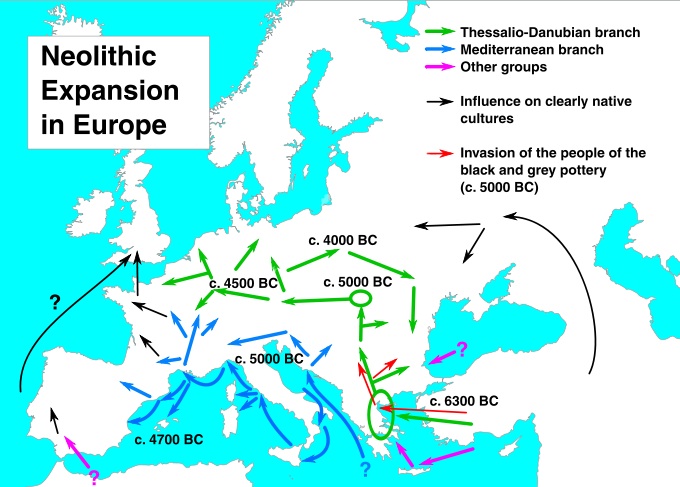
A DNA study suggests that early Neolithic people may have migrated into Europe about 9,000 years ago by island-hopping from Anatolia across the Mediterranean through the Dodecanese islands and Crete and across southern coastal routes.
Preistera Paschou and colleagues came to this conclusion after analyzing single nucleotide polymorphisms from a sample dataset of 32 populations, taken from the islands of Crete and the Dodecanese, Central Anatolia, Greece, Southern and Northern Europe, the Near East, and North Africa. They used a population genetics network approach that thye say determines the pathway of gene flow between populations.
Anthropologists and other scientists studying early Neolithic population migration have proposed three general routes that these early peoples may have taken to enter Europe. One was land-based to North-Eastern Anatolia and then through Bosporus and the Dardanelles and Thrace and into the Balkans; the second was maritime, from the Aegean Anatolian coast and across northern Mediterranean islands and along the coast of Southern Europe; and the third from the Levantine coastline across to the Aegean islands and into Greece. It is the second model that the recent genetic study most supports.
_________________________________
 Map of some earlier proposed theories related to Neolithic entry and expansion into Europe.
Map of some earlier proposed theories related to Neolithic entry and expansion into Europe.
________________________________________
“Our data support the Anatolian rather than the Levantine route because they consistently show the Aegean islands to be connected to the Near East through Anatolia,” write Paschou and colleagues in the research report*.
Genetics is not the only evidencial support cited for a maritime model. Archaeology has played its role. “Navigation across the Mediterranean was active during the Early Neolithic and Upper Paleolithic, as illustrated by the finding of obsidian from the island of Milos in Paleolithic sites of the Greek mainland and the early colonization of Sardinia, Corsica, and Cyprus,” add the authors………….”Archaeological evidence from Greek and Near Eastern and Anatolian Neolithic sites suggests that multiple waves of Neolithic migrants reached Greece and Southern Europe. Most likely multiple routes were used in these migrations but, as our data show, the maritime route and island hopping was prominent.”*
The detailed report is published in the Proceedings of the National Academy of Sciences (PNAS).
____________________________________
*PNAS Article #13-20811: “Maritime route of colonization of Europe,” by Peristera Paschou et al. http://www.pnas.org/cgi/doi/10.1073/pnas.1320811111
Cover Photo, Top Left: Coast of Greece with sunset. Hedwig Storch, Wikimedia Commons
_____________________________________________
Read about the most fascinating discoveries with a premium subscription to Popular Archaeology Magazine. Find out what Popular Archaeology Magazine is all about. AND MORE:
On the go? Purchase the mobile version of the current issue of Popular Archaeology Magazine here for only $2.99.
Popular Archaeology’s annual Discovery Edition eBook is a selection of the best stories published in Popular Archaeology Magazine in past issues, with an emphasis on some of the most significant, groundbreaking, or fascinating discoveries in the fields of archaeology and paleoanthropology and related fields. At least some of the articles have been updated or revised specifically for the Discovery edition. We can confidently say that there is no other single issue of an archaeology-related magazine, paper print or online, that contains as much major feature article content as this one. The latest issue, volume 2, has just been released. Go to the Discovery edition page for more information.






